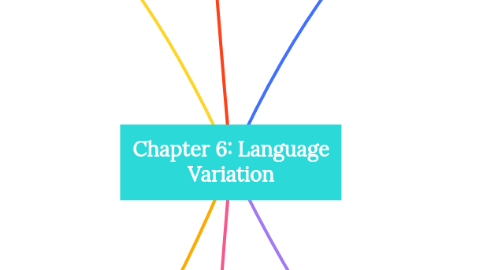
1. Regional Variation
1.1. Mapping dialects
1.1.1. Dialect geographers have traditionally attempted to reproduce their findings on maps in what they call dialect atlases.
1.1.2. Isogloss: A line on a map showing the geographical boundaries of the distribution of a particular linguistic feature.
1.1.3. A boundle of isoglosses mark a dialect boundary.
1.1.4. Wolfram (2004) calls the dialect of such an area a remnant dialect and, in doing so, reminds us that not everything in such a dialect is a relic of the past for such areas also have their own innovations
1.2. Methods in dialectology
1.2.1. Methodological issues: 1. Research Sample: sampling methods were based on assumptions about who ‘representative’ speakers of dialects were. 2. Basic ideas about language: The data collection methodology often used in earlier dialect geography studies assumes that individual speakers do not have variation in their speech.
1.3. Dialect mixture and free variation
1.3.1. Dialect mixture: the existence in one locality of two or more dialects which allow a speaker or speakers to draw now on one dialect and then on the other.
1.3.2. Free variation: variation of no social significance.
1.4. Linguistic atlases
1.4.1. They result largely from our growing ability to process and analyze large quantities of linguistic data.
1.4.1.1. Examples: Kretzschmar’s work on the Linguistic Atlas of the Middle and South Atlantic States (LAMSAS) Labov et al. 2005 worked on American English in order to produce the Atlas of North American English (ANAE)
2. The Linguistic Variable
2.1. Variants
2.1.1. A linguistic variable is a linguistic item which has identifiable variants, which are the different forms which can be used in an environment.
2.1.1.1. Examples: Singing and fishing pronounced singin’ and fishin’. The final sound in these words may be called the linguistic variable (ng) with its two variants [ŋ] in singing and [n] in singin’ farm and far. These words are sometimes given r-less pronunciations; in this case we have the linguistic variable (r) with two variants [r] and Ø
2.2. Types of linguistic variables
2.2.1. The (ng) variable has been widely used. The (r) variable mentioned above has also been much used. the (h) variable in words like house and hospital the (t) variable in bet and better (dh) variables in thin and they the final (t) and (d) in words like test and told, the vowel (e) in words like pen and men the (o) in dog, caught, and coffee the (e) in beg the (a) in back, bag, bad, and half and the (u) in pull
2.3. Variation in New York City
2.3.1. Labov (1966) chose five phonological variables: the (th) variable, the initial consonant in words like thin and three (dh) variable, the initial consonant in words like there and then the (r) variable, r-pronunciation in words like farm and far the (a) variable, the pronunciation of the vowel in words like bad and back the (o) variable, the pronunciation of the vowel in words like dog and caught
2.4. Variation in Norwich
2.4.1. Trudgill (1974) also chose certain phonological variables The consonant variables were 1- the (h) in happy and home 2- the (ng) in walking and running 3- (t) in bet and better 4- The thirteen vowel variables were 5- the vowels used in words such as bad, name, path, tell, here, hair, ride, bird, top, know, boat, boot, and tune
2.5. Variation in Detroit
2.5.1. Shuy et al. 1968) focused on the use of three variables:
2.5.1.1. A phonological variable was the realization of a vowel plus a following nasal consonant as a nasalized vowel. Two grammatical variables were multiple negation and pronominal apposition, for example, That guy, he don’t care.
2.6. Indicators, markers, and stereotypes
2.6.1. Labov (1972)
2.6.1.1. An indicator is a linguistic variable to which little or no social import is attached.
2.6.1.2. A marker can be quite noticeable and potent carriers of social information.
2.6.1.3. A stereotype is a popular and, therefore, conscious characterization of the speech of a particular group
3. Social Variation
3.1. Social class membership
3.1.1. Sociologists use a number of different scales for classifying people when they attempt to place individuals somewhere within a social system. Some systems are:
3.1.1.1. Occupational scale Educational scale
3.2. Social Networks
3.2.1. Milroy (1987) preferred to explore social network relationships and the possible connection of these to linguistic variation, rather than to use the concept of social class
4. it is a well-established part of the study of how languages change over time, that is, of diachronic or historical linguistics.
5. Data Collection and Analysis
5.1. The observer’s paradox
5.1.1. If language varies according to the social context, the presence of an observer will have some effect on that variation.
5.2. The sociolinguistic interview
5.2.1. The traditional sociolinguistic interview involves a casual interview, which ideally resembles a conversation more than a formal question and answer session. In addition to trying to make the interviewee feel comfortable enough to talk in a casual speech style.
5.3. Sampling
5.3.1. The importance of selecting a representative sample of speakers when studying language variation.
5.3.1.1. Random sample:
5.3.1.2. Judgment sample
5.4. Apparent Time and Real Time
5.4.1. Apparent time refers to the language of a particular group of speakers at a specific point in time. This means that people are grouped based on they age
5.4.2. Real time refers to changes that occur over time within a language community.
5.5. Correlations: dependent and independent variables
5.5.1. A dependent variable is the variable being studied (the one we are interested in), while an independent variable is a factor that may influence the dependent variable (social class, gender, ethnicity...).
5.6. Quantitative sociolinguistics
5.6.1. Quantitative sociolinguistics (also called variationist sociolinguistics) is a subfield of sociolinguistics that employs statistical analysis to study language variation. This approach involves collecting data on language use and social factors such as age, gender, and social class, and then analyzing the data to identify patterns and relationships.
